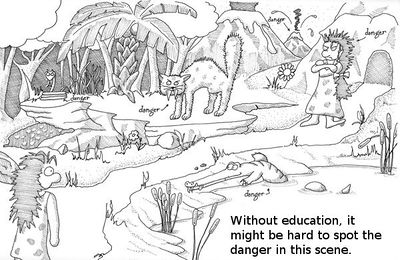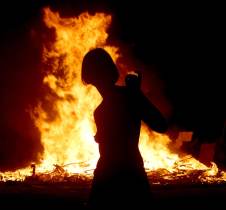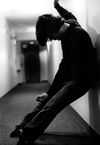Education
- You might be looking for Brainwashing and not even know it!
“Education is an admirable thing, but it is well to remember from time to time that nothing that is worth knowing can be taught”
– Oscar Wilde on Education
“War is Peace, Freedom is Slavery, Ignorance is Strength”
– The Ministry of Truth
The History of Education
“Enlighten the people generally, and tyranny and oppressions of body and mind will vanish like evil spirits at the dawn of day.”
The Dark Pre-Dawn of Education
Long ago, before the advent of civilized man, there was no such thing as formal education. Education began, like all things, wild, free, and dangerous. Sharp things cut, hot things burned, and "scary big thing with lots of teeth going to eat you watchout watchout" ate you. However, it soon became evident that this informal, experiential type of learning was doomed to failure through attrition.
At this time in history, education was limited to short bursts of important information, delivered after the experiential learning had occurred. Unfortunately, these bursts often resulted in bursts, due to the unfortunate timing necessitated by experiential learning. As a way around this, early man soon devised a cunning educational technique which became known as "oook!". Using the newly devised "oook!" technique, these primitive hominids were able to indicate that experiential learning was about to occur, so the student had better be paying attention. This is demonstrated in the following, fairly standard educational example:
- Scene fades in as Zook looks around, and spots a tiger.
- "Zook!" Zook exclaims, pointing at the tiger.
- The tiger eats Zook.
- Scene fades out as the tiger plays tug-of-war with Zook's esophagus.
In this educational example, Zook was only able to benefit from experiential education. See how badly it turned out for Zook? Now examine what happens when Zook is able to learn through the "oook!" method:
- Scene fades in as Zook looks around, and spots a tiger.
- "Oook!" points out Gook.
- "Oook?" Zook asks, pointing at the tiger.
- The tiger eats Zook.
- Scene fades out as the tiger plays tug-of-war with Zook's esophagus.
In this educational example, Zook learns a valuable lesson - "oook!" means, "Watch out, that tiger is going to eat you." In this way, Zook is able to learn a lesson through non-experiential means. Of course, Zook does not know that "oook" means this, and must learn it experientially. While this is not quite the sterling success it might seem, it laid the groundwork for more advanced educational techniques.
The Dawn of Education
For the better part of a few hundred thousand years, educational practices were limited to experiential learning and the "oook" method. However, better and brighter times were on the horizon, wrapped in the sparkling and exciting packaging of language.
While fairly useless in educating others about tigers, the "oook" method was fairly useful in educational situations dealing with fruit, rain, and small amounts of fire, as can be seen in the following educational example:
- Scene fades in as Zook is starting to reach towards a burning fire with his bare hand.
- "Oook!" points out Gook.
- "Oook?" Zook asks, looking back at Gook.
- "Oook!" confirms Gook.
- Zook sticks his hand in the fire for a second, then pulls it out and runs away screaming.
- Gook shakes his head and mutters, "Oook."
Obviously, in this example, Zook is able to connect his experiential learning to the utterance of "oook" by Gook. At the same time, due to the non-lethality of this experiential learning experience, Zook is able to add this to his danger-pain schema for future use and modification. As seen in this next educational example:
- Scene fades in as Zook is starting to reach towards a nice apple.
- "Oook oook." notes Gook, eating another apple.
- "Oook?" Zook asks, looking back at Gook, wide-eyed.
- "Oook!" confirms Gook.
- Zook backs away from the apple and runs away screaming.
- Gook shakes his head and mutters, "Oook."
As we can see here, Zook has been able to modify his danger-pain schema based on a combination of auditory and experiential learning. Obviously this event represents a great leap in educational technique, as Gook has just experienced the joys of educating the youth of today. Or of yesterday. Or of the Pleistocene epoch.
Obviously, the "oook" method is somewhat limited in the educational information that it is able to convey. Yet Gook is working on the subtle nuances of language, most easily seen in his body language and heard in the inflection of his "oook"s. Were this to come to fruition, education would take a sizable leap forward, like it did circa the beginning of the Holocene epoch:
- Scene fades in as Zook is starting to reach towards a burning fire with his bare hand.
- "Oook!" points out Gook.
- "Oook?" Zook asks, looking back at Gook.
- "Oook!" confirms Gook, smacking him upside the head.
- Zook sticks tongue out at Gook, and sticks his hand in the fire anyway.
- As Zook runs away screaming, Gook shakes his head and mutters, "Dumbass"
Here we can see how the advent of language exponentially increases the educational opportunities once solely available under experiential and "oook" methods. With such important groundwork laid, education was primed for rapid upward expansion, to be slowed only by bureaucracy and apathy.
The Mid-Morning of Education
With the advent of language, Education was primed to make a major leap forward. No longer did mid-morning man need to use "oook" for everything - now there were words like "Fire!", "Sharp!", "Cliff!", and "Holy Shit!". With such descriptive vocalizations, mid-morning man was able to build on concrete learning opportunities using analogy and relational syntax. This soon led to more formalized education, as tribes realized the value in standardized linguistic vocalizations, as can be seen in this educational example:
- Scene fades in as Zook, sitting around a fire with a group of other children, starts to reach towards a burning fire with his bare hand.
- "Hot!" points out Gook.
- "Hot?" Zook asks, looking back at Gook.
- "Hot." confirms Gook.
- Zook sticks his hand in the fire for a second, then pulls it out and runs away screaming.
- Gook shakes his head and mutters, "Dumbass."
- The other children watching repeat, "Hot, dumbass."
Thus via the great merger of experiential learning with verbal contextual syntax, educational opportunities were suddenly available to students not involved in the experiential part of the lesson. While seeming limitless to us modern folks, this educational technique had serious failings as it progressed from topics like "hot" and "sharp" to "terminal velocity" and "ice age". (Not to mention "mass extinction".)
The Noon of Education
Throughout the Middle Ages, education progressed little further than the verbal contextual syntax developed several thousand years before - as can be seen in this educational example:
- Scene fades in as Thomas is poking at a blackened corpse bleeding from the eyes.
- "Thomas," his mother nags, "Don't play with the plague victims. You might catch the plague."
- "Whatever, mom," replies Thomas.
- Fast forward effect with flipping calendar to indicate time has passed.
- Thomas is now a blackened corpse, being tossed into a cart as his family weeps.
- "See Frank, that's why I tell you not to play with the plague victims. I don't want what happened to Thomas to happen to you."
- Frank turns a bit paler, and hides a pointy stick behind his back.
As we can see, while the linguistic complexity of education has increased, the merger of experiential learning to verbal contextual syntax still represents the pinnacle of educational achievement. This, of course, is expected, as noon comes shortly after mid-morning brunch, when you're still full from the soufflé and not really ready to eat a sandwich or anything.
The Siesta of Education
After lunch, education took a nap. The Dark Ages came down like a black steel hammer and education was out for the count.
The Evening of Education
After the Dark Ages came a time known as the Renaissance, a time of education, art, architecture and the Spanish Inquisition. During this time education was finally able to move away from experiential learning, due to the massive influx of high-quality paintings and works of art. Such a shift can be seen in the following educational example:
- Jean-Luis is looking at a picture of copulation, "playing his flute" through a hole in his pocket.
- "Jean-Luis - doing this with Anna-Marie will make her have another baby. Do you understand?"
- "Holy shit," thinks Jean-Luis, "he's touching her boobies!"
The Dark Night of Education
Soon thereafter Victorian oppression took a pleasant evening jaunt and turned it into a stiff, stuck-up, politically-correct, overly formal oration, complete with straight-backed wooden chairs, monotone voices, and schedules. Education was done for.
Gone were the days of fluid, spontaneous experiential learning. Gone was the ability to say, "Hot, Dumbass." Gone was the exciting terror of learning that tigers were sharp at one end, fire was hot, and those slimy orangish mushrooms were not good to eat. All of this exciting, novel, and engaging learning was replaced with textual and graphic representations of such exciting events. No longer could one watch Zook get chased by a tiger, or Thomas pick up the plague from a rotting corpse. No longer could one learn how "not" to hunt a mammoth, by watching someone else do it incorrectly.
In the place of exciting and novel learning was "modern education". And it sucked.
In the Morning of Education, students were interested in learning. Education contained something valuable for them - entertainment, excitement, and and life-changing information. "Modern education" lacks all of that. And so we weep. For the children.
Philosophy of Education
As education has evolved, so has the philosophy of education. In the beginning, the philosophy was simple: We'd have more hunter-gatherers if they stopped getting eaten by tigers. In later times, the philosophy changed to align itself with: We'd have less trouble with the serfs if they thought that being poor was the key to Heaven.
In modern times, the philosophy of education became: If we can instill in the youth the essence of the old, they will skip their troublesome exploratory, rebellious days and become good workers faster.
Aligned with this, the fundamental purposes of modern education include:
- Educating young people to become responsible, mechanical, and reliable citizens.
- Keeping a status-quo in every practical field depends upon having individuals who are relieved of their creative burdens, and set free to do the mechanical work that a modern society requires.
- One's individual development and the capacity to fulfill society's purpose for you depends upon an adequate preparation in childhood. Education thus can attempt to give a firm foundation for the achievement of societal goals. The better the foundation that is built, the more successful the society will be.
With these fundamental purposes in mind, modern society began a revolution of educational methodology in the mid-to-late 1800s. From this revolution sprung a number of modern educational systems, most of which still exist today.
Types of Modern Education
In modern times, education is the slow, expensive process by which human children acquire meaningless information and useless skills to depress creativity and instill in them the mechanical programming that society requires in order for it to function. As has been shown often in the past, people lacking education often create world-changing ideas and movements when they reach the age where they start thinking about commingling their bodily fluids to create offspring. This in turn disrupts normal societal function, and leads to inefficiency and an influx of creative thinking. All this leads to revolution and change, both of which are obviously bad things. The following programs have been specifically and meticulously designed in order to prevent this:
Public Schooling
The bulk of society is educated in special buildings called "schools". These buildings are constructed locally to house our dangerous children who must be educated before they become creative, free thinkers and try to change the world. Schools isolate children from the rest of polite society so that their intelligence is not spontaneously displayed in front of other already educated people, which would threaten to rekindle some of their pre-education creativity.
High School
High School is a subset of public schooling, focused on instilling chemical dependence in students. Ultimately, this allows for greater societal control, when traditional High School pharmaceuticals are replaced with prescription drugs, mind altering drugs, mind destroying drugs, and alcohol. For the most part, students at a High School are unaware of their future roles in society, and thus find it an improvement on Low and Middle School, and substantially more enjoyable than Sober School. Perhaps one of the best examples of a typical High School is Stoner High School.
Religious Schooling
A prime example of religious schooling is a Catholic gradeschool. In such an establishment, students are expected to go far beyond the societal sculpting of a public school, adding to that experience a firm foundation of religious intolerance and non-standard world viewpoints. Unfortunately, it seems that many students who attend such religious schooling are unable to make this transition. Instead, they revert to their creative pre-schooling habits when they start thinking about commingling their bodily fluids to create offspring.
While detrimental to society, school, and religion, this unfortunate reversion has given rise to the Catholic School girl, which just can't be a bad thing.
Home Schooling
Home schooling is conducted by religious fanatics and their ilk in an effort to teach their children "The Truth", without the risk of creative reversion that Religious Schooling poses. The Truth, however, may consist of such questionable information as a necromancing rabbi named Jesus being the son of God, or that black people are intellectually inferior because of an additional bone in their feet.
While the attendees may indeed learn The Truth from home school, they are often looked upon as twisted freaks by us normal people, and rightly so.
In a positive light, home schooling has been shown to be at least equal to conventional schooling in reducing troublesome creativity. As a matter of fact, when the reason for Home schooling is religious, this percentage frequently exceeds 100%.
The School of Hard Knocks
Unfortunately, some foolish children decide that they are not going to stay in school until their education is completed. As a method to accommodate for their lack of modern education, these children are forced into degrading, humiliating service positions, where they are crushed with soul-destroying tedium until they lose enough creativity and intelligence that they are able to blend inconspicuously into the fabric of modern society.
Individuals who "graduate" from the "School of Hard Knocks" often consider their education to be superior to that garnered by graduates of more conventional educational systems. However, they're such stupid fuckers you would expect them to think that, wouldn't you?
Old School
Some people are just so cool that they can't go to normal school. In many Old Schools, one can find such curricular topics as:
- Computers
- Music Level 1
- Music Level 2 (taught by Grandmaster Flash)





